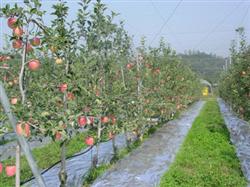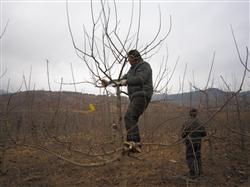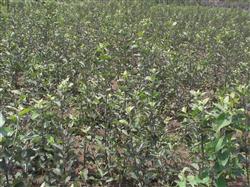How to plant young apple trees and give birth prematurely

How to plant young apple trees and give birth prematurely? Please give guidance so that young grass and fruit trees can refer to the following planting methods: 1 management techniques young trees are trees that have not entered or just entered the fruiting stage, with an age of 1 to 4 years, the key points of management and protection during this period: first, fast-growing trees; second, to form a high-yielding skeleton, able to load yield. 1.1 reasonable intercropping new orchards should firmly establish the idea of taking fruit trees as the management center. Under the premise of leaving enough tree ditches, intercropping crops, such as peanuts and cotton, can be reasonably arranged between rows. The distance between the crop and the tree row is 0.5m in one year and 1m in the second year. 1.2 Fertilizer and Water Management 1.2.1 topdressing (1) Underground topdressing: three times a year, namely: sprouting fertilizer was applied before germination in mid-March, long-term topdressing was applied from May to mid-June, and topdressing in rainy season was applied from July to August. Nitrogen fertilizer is the main fertilizer in the early growth stage, phosphorus and potassium fertilizer is the main fertilizer in the middle and late growth stage, and the first topdressing after planting is applied when the shoot is 10cm. The amount of fertilizer applied each time is determined according to the tree age and tree potential. Generally, 1 ~ 2-year-old trees are 50g 150g per topdressing, 3 ~ 4-year-old trees are 250g / 500g topdressing, and the topdressing method is multi-hole application, 1 ~ 2-year-old trees are 50cm away from the trunk, 6 10~15cm holes are dug deep around the tree, and 8 10~15cm holes are dug around the 3 ~ 4-year-old tree trunk. (2) aboveground topdressing (foliar spraying): young trees have poor absorption capacity because of underdeveloped roots, so foliar spraying of young trees is very important, spraying once every 10 to 15 days, mainly spraying nitrogen fertilizer and amino acid fertilizer before the end of July, and phosphorus and potassium fertilizer in the later stage. For the prevention and control of iron deficiency yellow leaf disease of young trees, the application of urea iron (0.3% ferric sulfate + 0.3% urea) or chelated amino acid iron can achieve a good control effect. 1.2.2 during the period of base fertilizer young trees, it is necessary to apply base fertilizer every year, and the application of base fertilizer can be completed from the middle of September to November. Biennial trees dig strip or ring ditches on both sides of the tree with wide 40cm and deep 50cm. Organic fertilizer is mainly supplemented by long-acting chemical fertilizer, and the amount of organic fertilizer is determined according to the tree potential and tree age. Generally, 50 kg organic fertilizer is applied per plant in 1-2 years and organic fertilizer 100kg is applied in 4-year-old trees. At the same time of fertilization, appropriate amount of micro-fertilizer should be applied according to the actual situation to ensure the balance of tree nutrition. (2) the trunk height of tree pruning technique is fixed in 100cm after planting, and the spindle-shaped tree is popularized. Therefore, the tree management in the growing season is very important, especially the branch pulling measure, the tree load, ventilation and light transmission, the occurrence of diseases and insect pests and the application of control measures are all related to the tree structure. In addition, it is necessary to do a good job of twisting, softening and misplaced branches in summer, and reasonable pruning in winter. In this way, a reasonable tree structure can be cultivated after planting for 3 to 4 years, which will lay a good tree foundation for preterm and high yield in the future. 2.1 before pruning and sprouting, 2-3 eye wounds were carried out at the specified stem height 70cm to increase the germination rate and increase the number of branches, and wipe off the shoots below the trunk 70cm before the branches were Lignified. Soften the new shoots in summer, so that the angle is 70-90 degrees, pay special attention to the control of competitive branches. 2.1.1 for the young trees with strong growth, large number of branches and many long branches, the branches below 70 years old should be removed in winter pruning, and the long branches above 70 years old should leave 6 to 8 branches with balanced growth and good orientation. Among them, 4 were main branches with an angle of 70 degrees, and 4 were auxiliary branches with an angle of 90 degrees, all of which were long and the other branches were thinned. The central leader branch is short, and the cutting length is about 60 inches. 2.1.2 for the moderately growing young trees in winter pruning, the competitive branches should be thinned, and the long branches with good orientation and strong growth should be selected to cut short at the full buds to promote the growth of long branches, and then be cultivated into main branches, the central leader should be cut short and the rest of the branches should be thrown out. 2.1.3 the young trees with weak growth should be heavily pruned in winter, the competitive branches should be thinned, and the rest should be released slowly. 2.2 pruning 2.2.1 pull branches before and after sprouting, the main branches are pulled close to the level, the auxiliary branches can even droop, and the main branches and auxiliary branches are engraved in many ways. From early May to early June, the upright strong shoots and over-dense shoots on the main branches and auxiliary branches were properly thinned, and other strong shoots could be coring and twisted for many times in a row. In autumn, the new shoots issued by the central leadership should be reasonably thinned, and the remaining branches should be softened, and another 3 to 4 main branches and 2 auxiliary branches should be cultivated in the central leadership, while the extended branches of the central leadership should be cut short by 50 to 60. 2.2.2 during winter shearing, remove the erect branches on the back of the first main branch, remove the competitive branches of the main branch extension branches, and extend the slow release of the branches. Remove the competitive branches of the elongated branches of the central leadership, leave 50-60 short branches, and leave 2 main branches and 2 auxiliary branches on the central leading trunk. 2.2.3 in winter pruning, 3-4 long branches were selected as main branches, 1-2 were auxiliary branches, erect vigorous branches were removed, and the remaining branches were thrown away. The central leading cadres should select and retain 2 main branches and 1-2 auxiliary branches, eliminate the competitive branches of the central leading cadres, and keep the extended branches short of 50~60cm. 2.3 pruning of three-year-old trees in the middle and last ten days of June, ring peeling or engraving measures were taken on the main branches and auxiliary branches to control the growth and promote the formation of flower buds; pay attention to balance the tree potential during winter pruning to prevent the upper and lower branches from being strong and weak, and the central leadership continued to cultivate 3-4 main branches and 2 auxiliary branches in the third layer, which required that the main branches should be misplaced and the interval was not less than 60cm. 2.4 the four-year-old tree has basically entered the early fruit stage, there are 15 main branches, the tree height is 3m, and the tree skeleton has been completed. at this time, pruning is mainly to control the balance of tree potential and then give birth prematurely. (3) Tree posture control and flower promotion measures although young apple trees are easy to blossom, they will not form enough flower buds if they are not controlled, so corresponding measures should be taken to ease the tree potential to promote flower bud formation, so as to achieve the technical effect of preterm and high yield. If the trunk diameter is more than 5cm and the four-year-old trees have a certain number of branches, the flower formation measures can be applied to transform the young trees from vegetative growth to reproductive growth. 3.1 pull branch opening angle this is the key technical measure to control the tree potential, the spindle-shaped main branch angle is 70-90 degrees, the rest of the branches are flat or drooping, pay attention to adjust the tree potential balance through the pull branch angle, the pulled branches do not circle, do not turn, maintain a line, to achieve: pull out of the level, pull out of balance, pull out of the tree, pull out level. 3.2 before and after branch transformation and branch enhancement techniques, directional or non-directional injury to the main branch and auxiliary branches were adopted to promote lateral branches, increase the number of short branches, make the long branches become short branches, change the vertical growth to horizontal growth, and form a branch structure dominated by short branches. the tree potential is relaxed, and then lay the branch foundation for flowering and fruiting. 3.3 to do a good job in the treatment in the tree chamber, the upright branches and excess branches in the tree chamber should be dealt with in time so as not to cause "chaos in the nest", which is not conducive to forming, affecting the light and not forming flowers, mainly by means of thinning, twisting, folding, pulling branches and changing direction, and so on. There are no branches in the 10cm away from the trunk, and the branch groups are separated by 20~30cm. Through the treatment of the branches in the chamber, the fruiting parts of the young trees were arranged reasonably and moved out gradually. 3.4 there are many chemical methods to promote flowers by spraying growth regulators, such as regulating the growth power of branches, increasing the accumulation of nutrients, and promoting and guiding flower bud differentiation. Spraying 300 times 10% paclobutrazol in early May and 150 times 10% paclobutrazol at the beginning of autumn shoot growth in mid-July can be sprayed several times according to the situation to achieve the effect. 3.5 the tree was girdled in mid-May, the width of the peeling mouth was 0.5cm, and the paste paper was protected, and then removed after 15 days. If the tree potential is unbalanced, the main branch should be girdled or girdled for many times. (4) Flower and fruit stage management of four-year-old trees entered the early fruit stage, at this time to do a good job in soil fertilizer and water, pruning, pest control at the same time, focus on flower and fruit management. It is necessary to adjust the balance between vegetative growth and reproductive growth to prevent premature senescence. Timely thinning of flowers and fruits, control of load, yield per mu 2000kg. Specific methods: keep an inflorescence at 15cm intervals during flowering, leaving a central flower and an edge flower for each inflorescence, and artificial pollination; after 20 days, leave a fruit with a straight drooping fruit or two sides of a strong short fruit branch, and remove the fruit on the back. This ensures that the fruit is high, large, neat and colored. (5) during the period of prevention and control of diseases and insect pests, leaf protection should be the main control. The main diseases and insect pests are: beetles, green blind bugs, aphids, night moths, leaf rollers, red spiders, early deciduous disease and so on. According to the actual situation, pyrethroids can be used to control green bugs and leaf rollers, imidacloprid is used to control aphids, imidacloprid 3 is used to control Spodoptera litura, mite lice is used to control red spiders, and early defoliation can be controlled with Nongkang 120 and Bordeaux solution. Click to get more apple tree planting techniques click to get more fruit planting techniques
- Prev

How to prune apple trees in the New year
How to prune apple trees in the New year? Please give guidance on the pruning principles of Chinese New year trees. On the premise of ensuring the yield of the same year, properly control the retention of flowers and fruits, reduce consumption, increase accumulation, and promote flower bud formation. The concrete method is: 1, the big year tree flower bud is many, in order to reduce the flower bud and improve the ventilation and light transmission condition, sparse or retract.
- Next

How to prune the prosperous apple tree
How to trim the apple tree? Please introduce the method: Apple prosperous trees are mostly young trees to the early fruit stage, in order to ease the tree potential, promote flowers and protect fruit, pruning should be done: 1, open backbone branch angle. Brace, pull, press and other methods are used to open the angle of backbone branches, and multi-saws can be used for perennial and vigorous backbone branches.
Related
- Moge, come on! The staff of the peasant association in the producing area of cantaloupe were frightened when the crowd gathered.
- Causes and Solutions of low Fruit setting rate of Apple
- Symptoms and control measures of passion fruit virus disease
- Fruit growing lesson: how do apple orchards keep high yields?
- Can you build orchards in the mountains? What are the pros and cons?
- How to manage the coloring period of Crisson grape?
- This paper introduces the processing technology of two kinds of fig products.
- How much is a month for retired teachers in rural areas by 2020?
- How can strawberry planting increase sugar content? We should pay attention to management in many aspects.
- What are the cultivation techniques on how to improve the yield of golden fruit?

